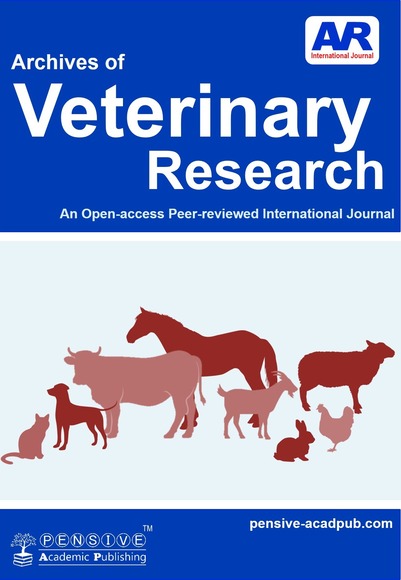Faecal shedding of Canine parvovirus in clinically healthy vaccinated pups
Parvoviral shedding in post-vaccination pups
DOI:
https://doi.org/10.70964/avr.6Keywords:
Canine Parvovirus (CPV), Polymerase Chain Reaction (PCR), Sequencing, Phylogenetic analysis, Real-time PCR, Faecal sheddingAbstract
Canine parvovirus (CPV-2) is an important dog pathogen that causes severe hemorrhagic enteritis. The incidence of vaccinated, clinically healthy puppies shedding either the field strain or the vaccine strain of CPV is not fully understood. Moreover, little is known about the duration and extent of CPV vaccine virus shedding in puppies. To explore this phenomenon further, the current study aimed to understand the dynamics of faecal shedding of CPV in clinically healthy, vaccinated puppies. In this study, 351 faecal swabs were collected from twenty-seven clinically healthy pups at intervals over six months post-vaccination. Samples were analyzed for canine parvovirus shedding using hemagglutination (HA), PCR and qPCR assays. Two of the 351 samples screened demonstrated an HA titer 1: 2 on the 3rd and 7th day following the primary vaccination. In contrast, the PCR assay identified fifteen positive samples on various days post-vaccination. Among 60 randomly analyzed fecal swabs, 55 tested positive using real-time PCR. Sequence analysis of both conventional PCR and real-time PCR products provided clear evidence of subclinical shedding of both the vaccine strain and the field strain of CPV among the vaccinated puppies. The study concludes that vaccinated puppies shedding the vaccine strain (CPV-2) in their faeces may help to provide herd immunity. Additionally, healthy vaccinated puppies that shed the field virus strain suggest local intestinal multiplication of the virus, which could be a source of CPV infection for unvaccinated puppies.
References
1. Appel, M.J., Scott, F.W. and Carmichael, L.E. (1979) Isolation and immunization studies of a canine parvo-like virus from dogs with hemorrhagic enteritis. Vet. Rec., 105(8): 156-159. https://doi.org/10.1136/vr.105.8.156
2. Parrish, C.R., Aquadro, C.F., Strassheim, M.L., Evermann, J.F., Sgro, J.Y. and Mohammed, H.O. (1991) Rapid antigenic-type replacement and DNA sequence evolution of canine parvovirus. J. Virol., 65: 6544-6552. https://doi.org/10.1128/jvi.65.12.6544-6552.1991
3. Vivek, S.V.M., Mukhopadhyay, H.K., Thanislass, J., Antony, P.X. and Pillai, R.M. (2013) Molecular epidemiology of canine parvovirus in southern India. Vet. World., 6(10): 744-749. https://doi.org/10.14202/vetworld.2013.744-749
4. Mukhopadhyay, H.K., Matta, S.L., Amsaveni, S., Antony, P.X., Thanislass, J. and Pillai, R.M. (2013) Phylogenetic analysis of canine parvovirus partial VP2 gene in India. Virus Genes, 48(1): 89-95. https://doi.org/10.1007/s11262-013-1000-5
5. Nookala, M., Mukhopadhyay, H.K., Amsaveni, S., Antony, P.X., Thanislass, J., Vivek, S.V.M. and Pillai, R.M. (2016) Full-length VP2 gene analysis of Canine parvovirus reveals the emergence of newer variants in India. Acta. Microbiol. Immunol. Hung., 63(4): 411-426. https://doi.org/10.1556/030.63.2016.010
6. Mukhopadhyay, H.K.,Mangadevi, N., Nobal RKT .Amsaveni, S., Antony, P.X., Thanislass, J., Mouttou Vivek S and Pillai,R.M. (2016). Molecular Characterization of Parvoviruses from domestic cats reveals emergence of newer variants in India. J. Feline Med. Sur. 55(3):202-209.
7. Bhaswanth K., Vivek Srinivas,V.M. Jayalakshmi V., Antony P.X., Rajkumar K., Venkatesa Permal S., Mukhopadhyay H. K. (2022). Phylodynamic and genetic diversity of parvoviruses of cats in southern India. Virus disease. 33(1): 108-113. https://doi.org/10.1007/s13337-022-00760-4
8. Reddy H, Srinivas VMV, Vasu J, Prabavathy A, Dhodapkar R and Mukhopadhyay HK. (2024). Whole-genome sequence analysis of canine parvovirus reveals replacement with a novel CPV-2c strain throughout India. Archives of Virology 169 (9), 1-23. https://doi.org/10.1007/s00705-024-06096-2
9. Decaro, N., Elia, G., Desario, C., Roperto, S., Martella, V., Campolo, M., Lorusso, A., Cavalli, A. and Buonavoglia, C. (2006) A minor groovebinder probe real-time PCR assay for discrimination between type 2-based vaccines and field strains of canine parvovirus. J. Virol. Methods., 136(1-2):65-70. https://doi.org/10.1016/j.jviromet.2006.03.030
10. Paul, M.A., Carmichael, L.E., Childers, H., Cotter, S., Davidson, A., Ford, R., Hurley, K.F., Roth, J.A., Schultz, R.D., Thacker, E. and Welborn, L. (2006) AAHA canine vaccine guidelines - report of the American Animal Hospital Association (AAHA) Canine Vaccine Task Force. J. Am. Anim. Hosp. Assoc. 42(2): 80-89. https://doi.org/10.5326/0420080
11. Comparative Immune responses of pups following Modified Live Virus vaccinations against Canine parvovirus. 2019. Jayalakshmi, V., Srinivas, V.M., Antony. P.X., Thanislass, J., Vijayalakshmi, P. and Mukhopadhyay, H.K. Vet. World. 12(9): 1422-1427. https://doi.org/10.14202/vetworld.2019.1422-1427
12. Carmichael, L.E., Joubert, J.C. and Pollock, R.V.H. (1981) A modified live canine parvovirus strain with novel plaque characteristics. Cornell Vet., 71(4): 408-27.
13. Carmichael, L.E., Pollock, R.V. and Joubert, J.C. (1984) Response of puppies to canine-origin parvovirus vaccines. Mod. Vet. Pract., 65(2): 99-102.
14. Proksch, A. L., Unterer, S., Speck, S., Truyen, U. and Hartmann, K. (2015) Influence of clinical and laboratory variables on faecal antigen ELISA results in dogs with canine parvovirus infection. Vet. J., 204(3): 304-8. https://doi.org/10.1016/j.tvjl.2015.03.009
15. Decaro, N., Desario, C., Elia, G., Campoly, M., Lorusso, A., Mari, U., Martella, V. and Buonavoglia, C. (2007) Occurrence of severe gastroenteritis in pups after canine parvovirus vaccine administration: A clinical and laboratory diagnostic dilemma. Vaccines, 25(7): 1161-1166. https://doi.org/10.1016/j.vaccine.2006.10.020
16. Freisl, M., Speck, S., Truyen, U., Reese, S., Proksch, A.L. and Hartmann, K. (2017) Faecal shedding of canine parvovirus after modified-live vaccinationin healthy adult dogs. Vet. Journal., 219: 15-21. https://doi.org/10.1016/j.tvjl.2016.11.011
17. Siedek, E.M., Schmidt, H., Sture, G.H. and Raue, R. (2011) Vaccination with canine parvovirus type 2 (CPV-2) protects against challenge with virulent CPV-2band CPV-2c. Berliner and Munchener Tierarztliche Wochenschrift, 124(1-2): 58-64.
18. Carmichael, L.E. 1980. Haemagglutination (HA) and Haemagglutination Inhibition (HI) tests for Canine parvo virus. Am.J.Vet.Res. 41: 781-791
19. Buonavoglia, C., Martella, A., Pratella, M., Tempesta, A., Cavalli, D., Buonavoglia, G., Bozzo G., Decaro, N. and Carmichael, L.E. (2001) Evidence for evolution of canine parvovirus type-2 in Italy. J. Gen. Virol., 82(12): 3021-3025. https://doi.org/10.1099/0022-1317-82-12-3021
20. Gonuguntla, H.N., Surendra, K.S.N.L., Rana, S.K., Ponnanna, N.M., Subramanian, B.M., Sharma, G.K. and Srinivasan, V.A. (2016) Detection and Typing of CPV with Real-Time PCR and Mini-Sequencing. Adv. Anim. Vet. Sci., 4(4): 187-194. https://doi.org/10.14737/journal.aavs/2016/4.4.187.194
21. Bergmann, M., Schwertler, S., Speck, S., Truyen, U., Reese, S. and Hartmann, K. (2019) Faecal shedding of parvovirus deoxyribonucleic acid following modified live feline panleucopenia virus vaccination in healthy cats. Vet. Rec., 185(3):83. https://doi.org/10.1136/vr.104661
22. Meggiolaro, M. N., Ly, A., Rysnik-Steck, B., Silva, C., Zhang, J., Higgins, D.P., Muscatello, G., Norris, J.M., Krockenberger, M. and Šlapeta, J. (2017) MT-PCR panel detection of canine parvovirus (CPV-2): Vaccine and wild-type CPV-2 can be difficult to differentiate in canine diagnostic fecal samples. Mol Cell Probes., 33: 20-23. https://doi.org/10.1016/j.mcp.2017.02.007
23. Kantere, M. C., Athanasiou, L. V., Spyrou, V., Kyriakis, C. S., Kontos, V., Chatzopoulos, D. C., Tsokana, C. N. and Billinis, C. (2015) Diagnostic performance of a rapid in-clinic test for the detection of Canine Parvovirus under different storage conditions and vaccination status. J. Virol. Methods., 215-216: 52-5. https://doi.org/10.1016/j.jviromet.2015.02.012
24. Decaro, N., Crescenzoa, G., Desarioa, C., Cavallia, A., Losurdoa, M., Loredana, M., Colaianni, Ventrellaa. G., Rizzic, D., Aulicinoc. S., Lucentea, M. S. and Buonavoglia, C. (2014) Long-term viremia and fecal shedding in pups after modified-live canine parvovirus vaccination. Vaccine, 32(30): 3850-3853. https://doi.org/10.1016/j.vaccine.2014.04.050
25. Miranda, C., Carvalheira, J., Parrish, C.R. and Thompson, G. (2015) Factors affecting the occurrence of canine parvovirus in dogs. Vet. Microbiol., 180(1-2): 59-64. https://doi.org/10.1016/j.vetmic.2015.08.002
Downloads
Published
How to Cite
Issue
Section
License
Copyright (c) 2024 © 2024 Pensive Academic Publishing. All rights reserved. | Archives of Veterinary Research

This work is licensed under a Creative Commons Attribution 4.0 International License.




